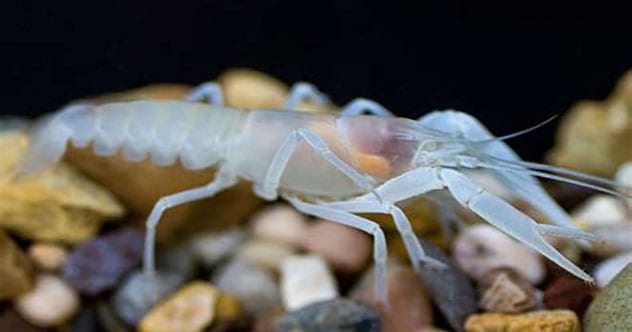When you stop to think about it for a moment, there are actually a lot of animals that don’t have eyes. Jellyfish, Hydras, Sea Urchins, Sea Cucumbers, worms, and many more critters never evolved a means of looking around, and instead, use other means to make their way in the world.
Other than those animals, there are some that either had eyes at one point in their evolutionary history, and lost them over time, or they evolved eyes that were later rendered incapable of seeing. Whatever their evolutionary niche, these ten interesting animals lost their ability to see the world around them but found innovative ways of surviving.
10 Interesting Theories Of Evolution You Have Never Heard About
10 Blind Legless Lizard – Dibamus Dalaiensis
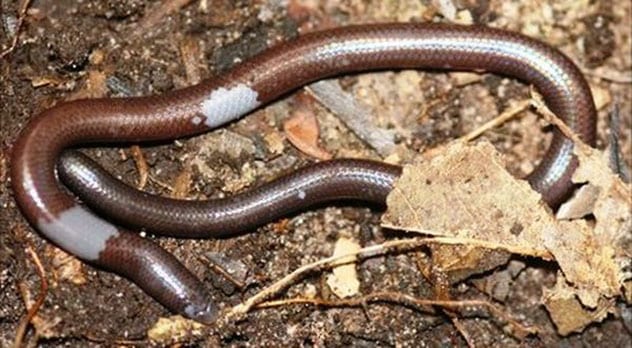
A new species of legless lizard was discovered in 2011, and as the name suggests, it’s completely blind. These interesting animals have some of the characteristics of snakes but fall under the Dibamidae family of blind skinks. Though they look similar, they have external ears, and depending on the gender, they may have small protuberances where legs would normally be located. The new species was discovered in Cambodia and marks the first time an animal of its kind was located in the Southeast Asian nation.
The Blind Legless Lizard of Cambodia evolved not to need eyes, as it spends nearly its entire life burrowing through the soil. According to one researcher, when it comes to eyes, “Those adaptations are simply a waste of energy when you’re working your way through underground tunnels.” Legless lizards evolved prior to snakes, and many species, including this newly discovered one, are threatened. D. dalaiensis, as far as any researcher is aware, lives in a small area on a single mountain in Cambodia, which is under threat from logging and other industries.[1]
9 Brazilian Blind Characid – Stygichthys Typhlops
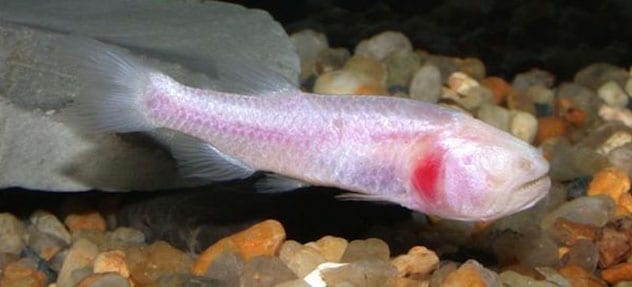
In the caves of Minas Gerais, Brazil, lives the Brazilian Blind Characid, a species of cave-adapted fish, which has evolved to no longer need eyes, or pigmentation. Like other species of tetra, they are small fish, measuring up to 1.8″ (4.6 cm), and live a relatively solitary life in their cave ponds. In the wild, they are becoming rarer, due, in large part, to a reduction in the local water table, which has resulted in the drying up of numerous ponds and streams. Despite their decline int the wild, they are sometimes kept in aquariums as pets, where they are prized for their unique features.
The fish was initially discovered in the 60s and was later rediscovered in the early 2000s. Since that time, only a limited population has been studied in their native habitat, as well as in laboratories, where their behavior could be monitored. They have no reaction to light, and there are no visible eyes, where they would normally be located in other tetra species. They are the last remaining species of Stygichthys, and there was once a surface variant, but habitat loss has likely resulted in its extinction. The Brazilian Blind Characid is limited to a 25km-long aquifer and is threatened by habitat loss due to a lowering of the local water table.[2]
8 Kentucky Cave Shrimp – Palaemonias Ganteri
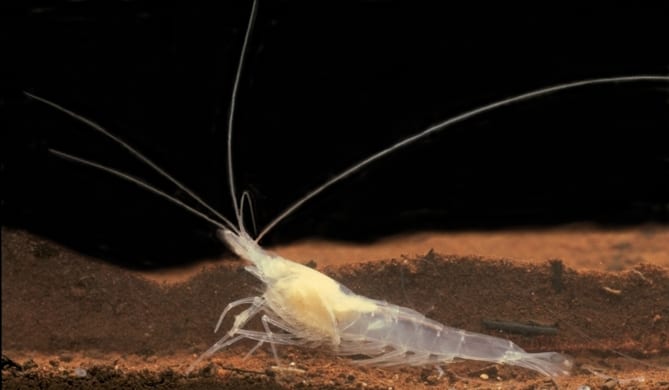
The Kentucky Cave Shrimp is a freshwater species of troglobite shrimp found in the caves of Barren, Edmonson, Hart, and Warren Counties, Kentucky. The species has evolved without eyes of any kind, and its shell lacks pigment, making it almost entirely transparent. They live exclusively in underground streams found in caves and can be found mostly in Mammoth Cave National Park. They survive in the low energy environment off of the sediment that washes into the cave via the movement of groundwater. Within the sediment, they find a rich bounty of protozoans, fungi, algal cells, and other organic materials.
Most species of shrimp possess small eyestalks topped with ocular receptors of some type, but the Kentucky Cave Shrimp evolved without these and has no way of sensing light. They look much like Ghost Shrimp, a common species found in many aquariums. Unlike Ghost Shrimp, the Kentucky Cave Shrimp is threatened due to its limited range. It only occupies a small area within Kentucky and is suffering in that area due to poor water quality resulting from a deterioration via groundwater contamination. Fortunately, conservation efforts are underway to ensure this strange animal doesn’t disappear from the world.[3]
7 Olm – Proteus Anguinus
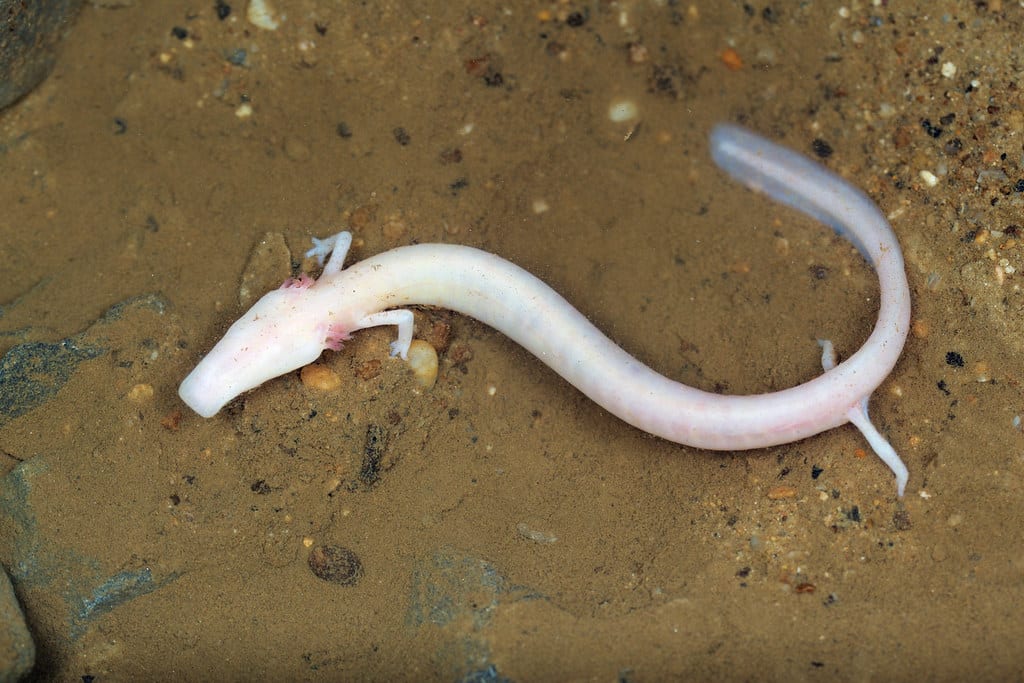
An Olm is a species of aquatic salamander, which is the sole cave-dwelling chordate in Europe. It is entirely aquatic, which is unusual for any amphibian, and it is found solely in caves in the Dinarcip Alps, where it spends its life eating, sleeping, and breeding underwater. Their fleshy skin color has earned them the nickname of “human fish” by the locals, and it has a rich history dating back hundreds of years. The first examples were identified in 1689, where the locals found them washed up after heavy rains. They were believed to be the offspring of a cave dragon, but sadly, they are mere salamanders, and cannot breathe fire.
Unlike some of the other species on this list, the Olm possesses eyes, but they are undeveloped and incapable of seeing any light. It uses its other senses of smell and hearing to navigate its dark environment. Their eyes are formed into small slits, which are completely covered by transparent skin, leaving no eyelids and no other “seeing” features. They have small limbs, with three toes on their forearms, and two on its hind feet, and they lack pigmentation, which is why they have a fleshy, earthworm look to their skin.[4]
6 Kaua’i Cave Wolf Spider – Adelocosa Anops
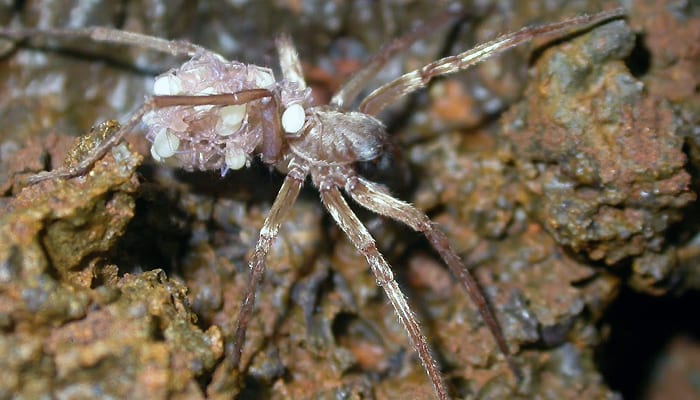
The Kaua’i Cave Wolf Spider is a blind spider found in only a few caves located in the Koloa–Po’ipu region of Kaua’i, Hawaiian Islands, where only six populations have been observed. They are relatively small for wolf spiders, and only reach a body length of around 0.8″ (20 mm). Their above-ground cousins have large eyes, but the Kaua’i Cave Wolf Spider has evolved to no longer need them—it has no eyes, whatsoever. They are completely harmless to people, and instead, prey almost exclusively on a small amphipod found in its environment, which itself is limited to only nine populations in the same area.
Because of their limited range in the caves of Koloa–Po’ipu, the spider is under threat of habitat loss and deterioration. This has resulted from human intervention and activities, which have contaminated their habitat. The biggest threat has been the use of chemical and biological pest controls, which kills their intended prey species, resulting in significant losses to the known populations of the Kaua’i Cave Wolf Spider. They are currently listed as endangered, and efforts are underway to limit their habitat loss to ensure their survival.[5]
10 Amazing Evolutionary Discoveries In Prehistoric Creatures
5 Widemouth Blindcat – Satan Eurystomus
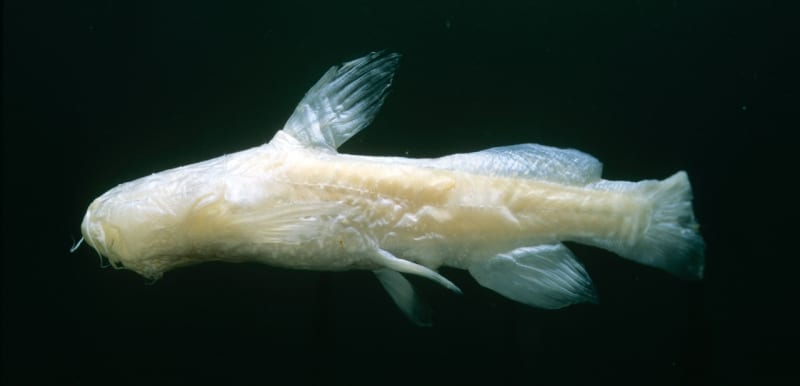
The Widemouth Blindcat is a species of catfish found in Texas, and the only member of the genus Satan. Yes, Satan. The species was first identified in a dark well, indicating it evolved to live in a lightless, subterranean environment. It is currently found in only five artesian wells in and around San Antonio, Texas. They lack pigmentation, and as their name implies, they have no visible eyes on the outside of their bodies. They do have eye remnants, suggesting they once had eyes but evolved to no longer need them. Their ocular remnants are incredibly reduced in size, and have little to no trace of a retina or lens, though the optic tract is present, it doesn’t reach the brain.
The Widemouth Blindcat is comparatively smaller than typical catfish and only grows to a length of around 5.4″ (13.7 cm). They have been found with crustacean skeletons in their stomachs, which implies they are a top-tier predator in their environment. Because of groundwater contamination, they are currently listed as vulnerable, and their population has been noted as declining. Conservation efforts are underway, but there are significant challenges due to their limited range to only a small area in central Texas.[6]
4 Blind Albino Cave Crab – Munidopsis Polymorpha
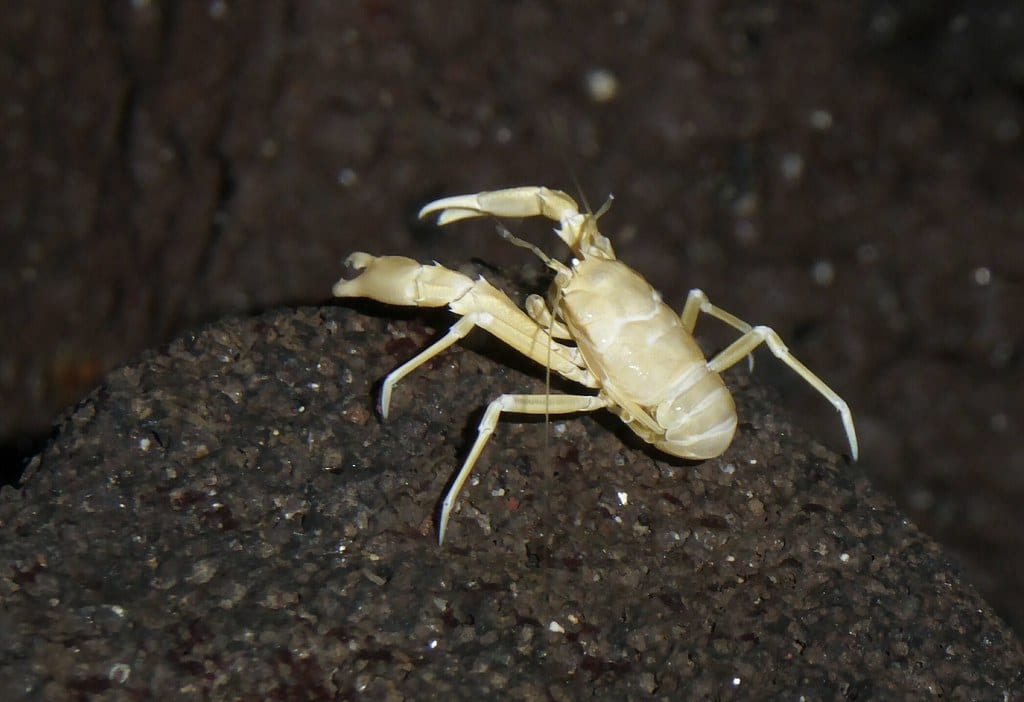
The Blind Albino Cave Crab is a species of squat lobster found only in the caves of Jameos del Agua in Lanzarote, Canary Islands. They are small, pale in color, and completely blind. They live exclusively in lava tubes, which were created thousands of years ago after seawater flooded into the caves created by volcanic eruptions. They are unique to their environment and very little has been learned about them since their identification in 1892. Despite the little known about them, they represent the animal symbol of the island of Lanzarote.
The Blind Albino Cave Crab lives in a cave, which can be visited and is even listed on Trip Advisor as a good place to check out while visiting Lanzarote. Physically, they look like tiny lobsters, which is actually what they are, despite what their name implies. They lack pigmentation and have no eyestalks of any kind. They have no reaction to light and get around by using their senses of smell, taste, and touch. Unlike most of the species on this list, they are not currently listed as threatened by the International Union for Conservation of Nature.[7]
3 Southern Cave Crayfish – Orconectes Australis
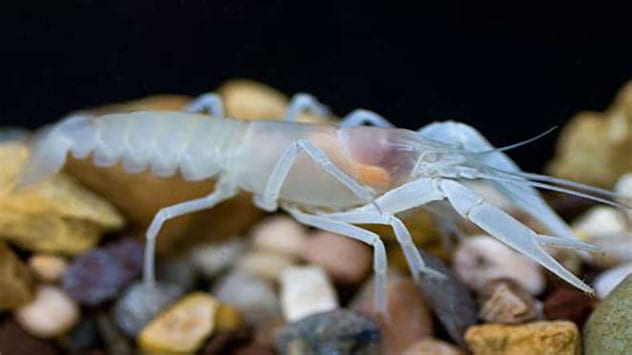
There are several aspects of the Southern Cave Crayfish, which make it an interesting specimen for study. One of the most important details about this critter is that it is a centenarian species, which means it can live in excess of 100 years, and one reported example of a Southern Cave Crafish was noted to be more than 176 years in age. The Southern Cave Crayfish looks much like other species of crayfish, though it lacks pigmentation, making it translucent, and it has no eyes or any reaction to light. They are found in subterranean cave waters of Alabama and Tennessee, where it is listed as being of least concern for survival.
They measure up to about 1.8″ in length, and have adapted to their surroundings such that they don’t need to see to get around, which is good seeing as there isn’t any light where they live. They subsist on small fish and insects, as well as whatever they can suck from the sediment washed into their environment via groundwater. They have been observed clinging to walls, on banks, and within open water, where then enjoy burying themselves beneath rocks.[8]
2 Mexican Tetra – Astyanax Mexicanus
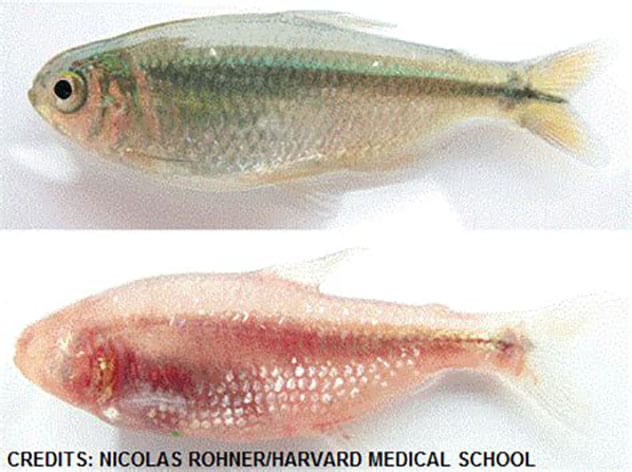
The Mexican Tetra is a species of characin found in the freshwaters of the Rio Grande, the Nueces, and Pecos Rivers in Texas, as well as various bodies of water in the central and eastern parts of Mexico. The fish grow to an impressive 4.7″ (12 cm), which is fairly large for a tetra and has no pigmentation, or eyes of any kind. Like the Brazilian Blind Cavefish, the Mexican Tetra is popular among aquarists, where it is often kept in cave-style tanks requiring minimal illumination.
These fish originally had eyes, as their surface-dwelling cousins still do, but over time, they evolved to lose them. Energy conservation is incredibly important in their environment, and scientists have surmised that they lost their eyes over time, as they no longer needed them. A published study determined that “for young, developing fish, the energy cost of sight is 15 percent greater than if they were blind.” This was due to the energy-hungry needs of photoreceptive cells and neurons, which the fish completely lacks. To compensate for their lack of eyesight, they scoop up and eat everything they come across, including dead animals and plants.[9]
1 Texas Blind Salamander – Eurycea Rathbuni
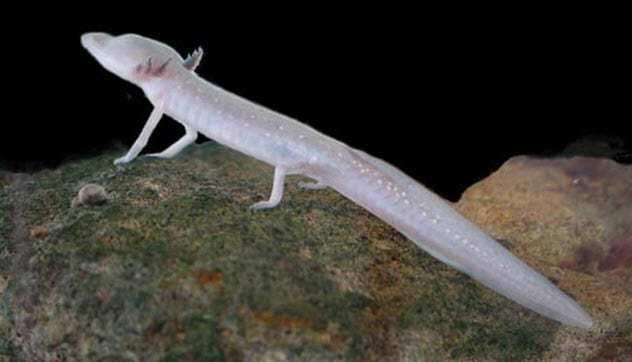
The Texas Blind Salamander is an incredibly rare species of troglobite amphibian found only in San Marcos, Texas, where it can be found in the San Marcos Pool of the Edwards Aquifer. They can reach lengths of up to 5″ (13 cm), and their diet enables them to subsist on whatever happens to flow into its dark environment. This can include a species of blind shrimp, snails, small fish, and anything else they come across. The species was first identified in 1895 when they were extracted from a newly constructed well, which drew water from a depth of 58 meters below the surface. Since that time, they have been studied from seven known locations in and around San Marcos.
Because the Texas Blind Salamander lacks eyes, possessing only subdermal sightless black dots where eyes would normally be, it hunts by sensing water movement in its environment, which is normally completely still. It hunts by moving from side-to-side, as it senses water pressure changes. They are rare, due to their limited range, and because of pollution to the groundwater in their area, their population has been on the decline. The IUCN has listed them as vulnerable, and conservation efforts are underway to protect them in their native habitat.[10]
Top 10 Surreal Animals That Really Exist
